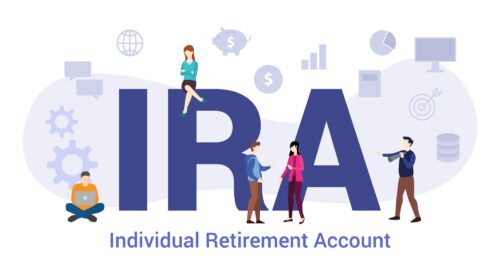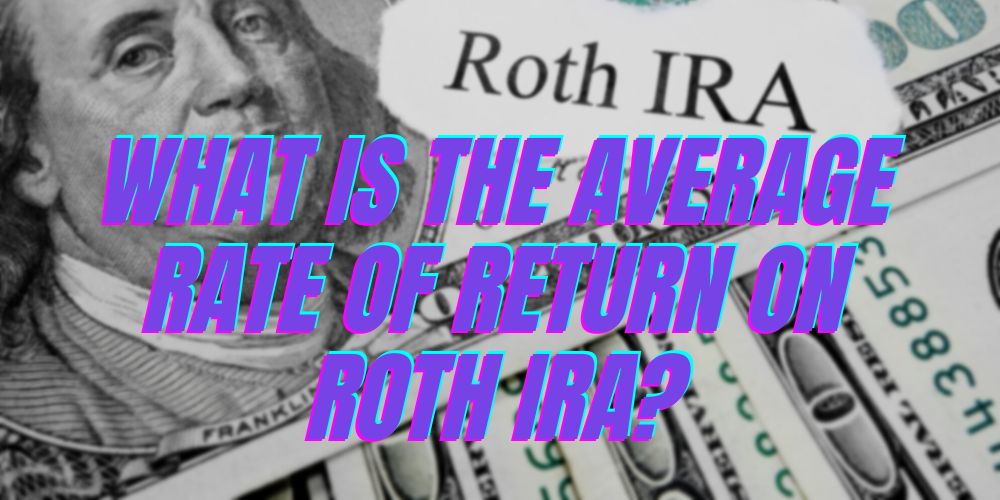When it comes to saving for your golden years, there are many options to choose from. One popular choice is the Roth IRA, which offers tax-free growth and distributions in retirement. But what is the average rate of return on a Roth IRA? Read on to find out.
What Is Roth IRA?
A Roth IRA is a tax-advantaged individual retirement account that allows you to save after-tax dollars for retirement.
With a Roth IRA, your contributions are not tax-deductible, but your earnings and withdrawals are tax-free once you reach retirement age.
Because of its tax advantages, a Roth IRA could be a great way to save for retirement while still enjoying tax-free earnings.

Types of IRA
The four main types of IRA are traditional, Roth, SEP, and SIMPLE.
Each of these IRA options has slightly different tax advantages and eligibility criteria, so it’s important to consider which type is right for your financial situation when you’re planning for retirement.
Traditional IRA
A traditional IRA allows you to make contributions that are tax deductible. This means that you could deduct your contributions from your taxable income.
The money in the account grows tax-deferred, meaning that no taxes are due on the interest or investment gains until you withdraw it during retirement.
Traditional IRA retirement withdrawals are taxed at ordinary income rates.
Roth IRA
A Roth IRA is not tax deductible and allows you to contribute after-tax dollars, which could grow over time without tax.

Investors could enjoy the benefits of tax-free growth on their investments even though it does not offer tax deduction upfront.
SEP IRA
A SEP IRA, or Simplified Employee Pension IRA, is specifically designed for small business owners, freelancers, and self-employed individuals.
With a SEP IRA, you could make tax-deductible contributions to your account, and it applies the same tax laws as traditional IRA withdrawals.
The contributions made by business owners who set up SEP IRAs for their employees are tax deductible, but employees can’t make contributions to SEP IRAs.
SIMPLE IRA
A SIMPLE IRA, or Savings Incentive Match Plan for Employees IRA, is also designed for small businesses with the same tax rules that apply to withdrawals with traditional IRAs and SEP IRAs.
But unlike SEP IRA, it allows employees to make tax-deferred contributions into an account managed by the employer, which may then be matched with company contributions.
How Does a Roth IRA Work?
You can set up Roth IRAs with most financial institutions, including banks, credit unions, and brokerage firms.
You’ll be able to choose from an array of investment options depending on what type of institution you go with.

To open a traditional or Roth IRA, you must receive taxable yearly compensation, including wages, tips, commissions, and bonuses.
Contributions cannot be made in the form of securities or other property; they must all be made in cash.
You don’t have to put money in your Roth each year, but you have to ensure that you don’t go over the contribution limits set by Internal Revenue Service (IRS).
The main difference between a Roth and other types of IRAs is that you fund your Roth with after-tax dollars so that you won’t be taxed in retirement on any money earned from dividend payments or capital gains on investments.
Your Roth IRA contribution could grow tax-free, and you won’t have to pay any tax on withdrawals as long as you meet some specific rules when accessing the money.
A Roth IRA is more flexible than other IRAs because you begin withdrawing your savings tax-free once you reach age 59 1/2 or become disabled.
What Is the Average Rate of Return on a Roth IRA?
A Roth IRA’s average annual return rate is typically between 7% and 10%.
This depends on various factors, such as the performance of the investments held in your account, the amount you contribute each year, and how long you have before you withdraw your funds.
At a 7% annual return rate, you could expect to see your investment grow over time. Let’s say you invest $10,000 and earn 7% annually for the next 20 years.
After 20 years, your initial investment will have grown to about $33,500 – that’s a gain of about $23,500.
And if you continue to reinvest those earnings at 7% annually, your original investment and all the earnings generated from it would grow to over $200,000 in 50 years.
That’s a total gain of nearly $190,000 just from compound interest alone.
Of course, these are just some example numbers.
In reality, the returns you’ll earn on your investments will depend on several factors, such as the performance of the financial markets and your own investing strategy.
But the basic principle remains the same. Over time, small investments could add up to big gains thanks to compound interest.
How to Project IRA Growth
To project individual retirement plan growth and returns, you must consider a few different factors. Some of the considerations are discussed in detail below.

Type of assets
Stocks generally have higher returns than most other assets since they tend to carry more risk but offer greater growth opportunities.
On the other hand, when it comes to bonds and cash equivalents such as certificates of deposit (CDs), these investments usually have much lower returns over time.
In fact, many people would be wise to avoid putting their money into CDs entirely due to how little they could earn over a long period of time.
General market performance
This could be assessed by looking at historical stock market data and trends, as well as projections from professional analysts or economists.
You might also wish to speak with a certified financial planner or other financial advisors who can help you understand how economic changes might affect your retirement savings.
Associated fees
These fees include account maintenance fees, mutual fund expense ratios, investment management fees, commissions on trades or deposits/withdrawals, and taxes on capital gains or dividends.
These costs could vary significantly from one provider to another and should be considered when deciding which IRAs to open with which providers.
It could have an impact on your overall returns, especially over the long term.
Alternatives to IRAs
In addition to IRAs, there are several other alternatives that could help you save for your retirement.
Some of these include other types of retirement accounts like 401(k)s, education investment accounts, and non-retirement investment vehicles on a brokerage account.

401(k)s
A 401(k) is an employer-sponsored plan that allows employees to save money for retirement through their employer’s payroll deduction system without paying taxes on that money until it is withdrawn from the account.
Some 401(k) accounts have investment options that allow employees to choose how their money will be invested.
These investments usually include stocks, bonds, or mutual funds, but they may also include other types of investments like real estate or precious metals.
One key benefit of a 401(k) is that employees can contribute to the account even if they are already contributing to other retirement savings accounts like an IRA or a Roth IRA.
In addition, some employers may offer matching contributions or profit-sharing bonuses that are based on the performance of the individual employee’s 401(k) account.
Related: States With No Taxes On Retirement Income
Why It Might Be Time To Rethink Retirement Investing
Education Investment Account
The 529 educational plan is an investment account that allows parents, relatives, and friends to set up tax-advantaged savings accounts for the future education expenses of a child.
Each state has its own rules governing 529 plans, but generally, you could use funds in a 529 plan to pay for qualifying college expenses like tuition and room and board.
Compared to traditional savings vehicles like checking or savings accounts at banks or credit unions, these dedicated investment accounts often offer more favorable tax treatment and investment options.
Brokerage Account
A brokerage account is an investment account that allows you to buy and sell stocks, bonds, mutual funds, exchange-traded funds (ETFs), options, and other investments.
Brokerage accounts can be individual or joint accounts held by two people who are co-owners of the assets.

When you open a brokerage account with a financial services firm such as a bank or brokerage firm, the company will provide information about the fees associated with trading different types of investments.
These fees may be flat-rate charges that are set at certain levels depending on the size of your assets, or they might be a percentage of assets under management (AUM).
Some brokerages charge additional trading fees for each transaction if made by phone or through an online stockbroker service rather than through the firm’s online trading platform.
Benefits of an IRA
One of the biggest benefits of an IRA is the tax advantages it offers.
Depending on which type of IRA you choose, your contributions might be tax deductible, which means that you don’t have to pay taxes on them until you withdraw the money from your account during retirement.
Some withdrawals may be tax-free in retirement, just like with Roth IRA accounts.
Another key benefit of an IRA is its flexibility. With most IRAs, you have more control over how you invest your money and when you make contributions compared to 401(k) accounts.

For example, many IRAs allow you to choose from various investment options, including stocks, bonds, mutual funds, and exchange-traded funds (ETFs).
You could adjust your contributions at any time based on your current financial situation, whether that means increasing your contributions or stopping them for a period of time.
Lastly, IRAs generally receive special protection under federal bankruptcy laws and state statutes, which means that creditors cannot access your assets held in an IRA.
However, there are exceptions to this, including permission from a court or as part of a marital property settlement or child support order.
This provides you with a measure of protection from creditors if you are ever involved in a legal dispute.
Disadvantages of an IRA
The fact that the annual contribution limits are relatively low is a disadvantage of using IRAs.
A 401(k) plan allows for contributions of up to $20,500 in 2022, but an IRA only allows for contributions of $6,000. The maximum annual IRA contribution is $7,000 if you are at least 50 years old.
Another drawback would be the early withdrawal penalty, which typically applies when you withdraw money from the account before reaching age 59 ½.
This could be a deterrent for many investors who are looking to use their retirement savings as a source of funds before they retire.
There might also be tax implications associated with early withdrawals, depending on the type of IRA and whether or not it is subject to income taxes.
Final Thoughts
A Roth IRA is one option to consider if you’re considering saving for retirement. It offers several tax breaks that could save you money in the long run.
The average rate of return on a Roth IRA is difficult to predict because it varies depending on stock market conditions, the types of investments you choose, and how long you keep your money invested.
You might also like:
Looking To Retire? These 6 Stocks Can Help Generate Regular Income
The 10 Best Monthly Dividend Stocks For Income Investors
What Are The Biggest Mistakes People Make When Investing for Retirement? Experts Explain


 Tags:
Tags:










